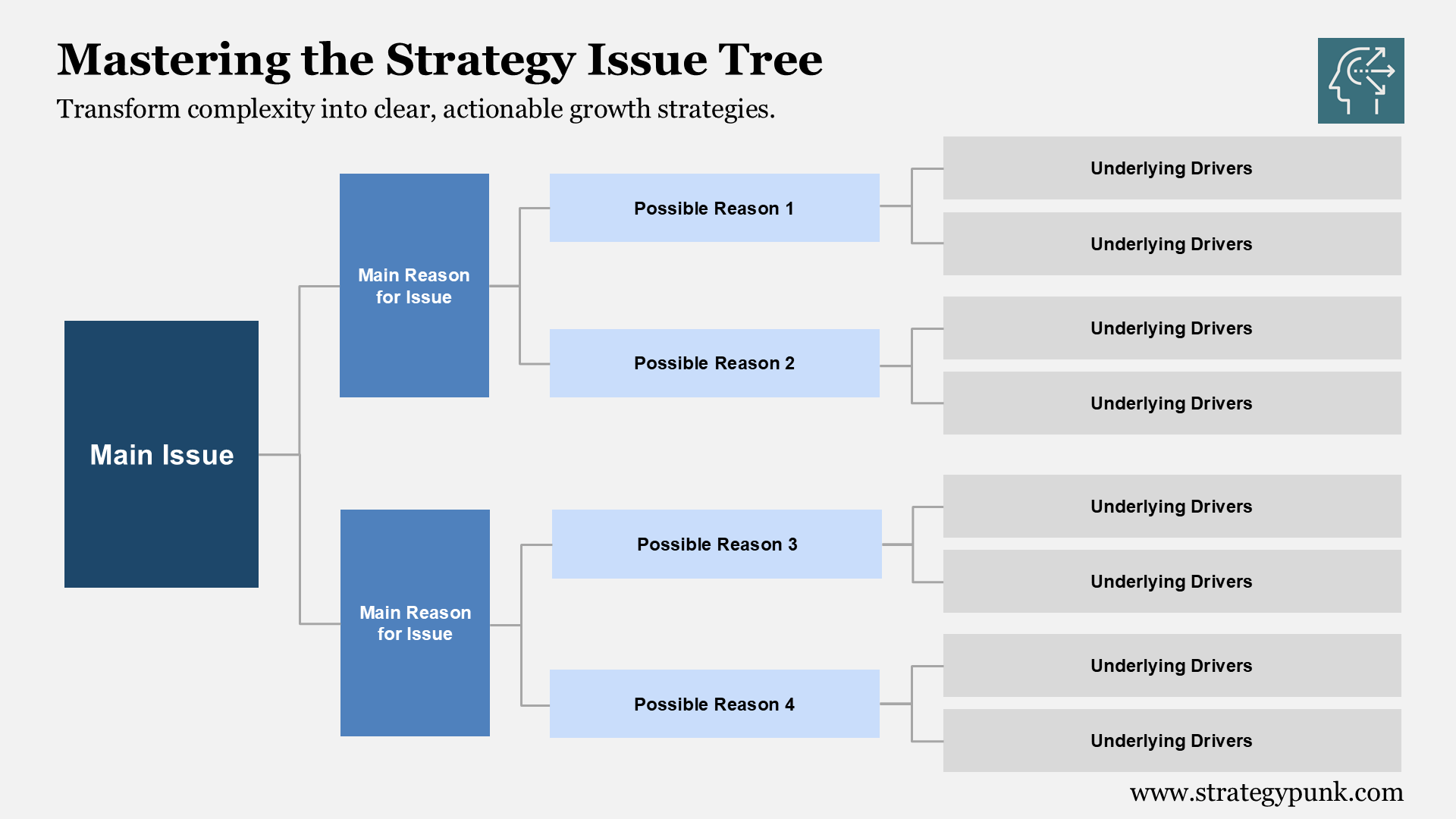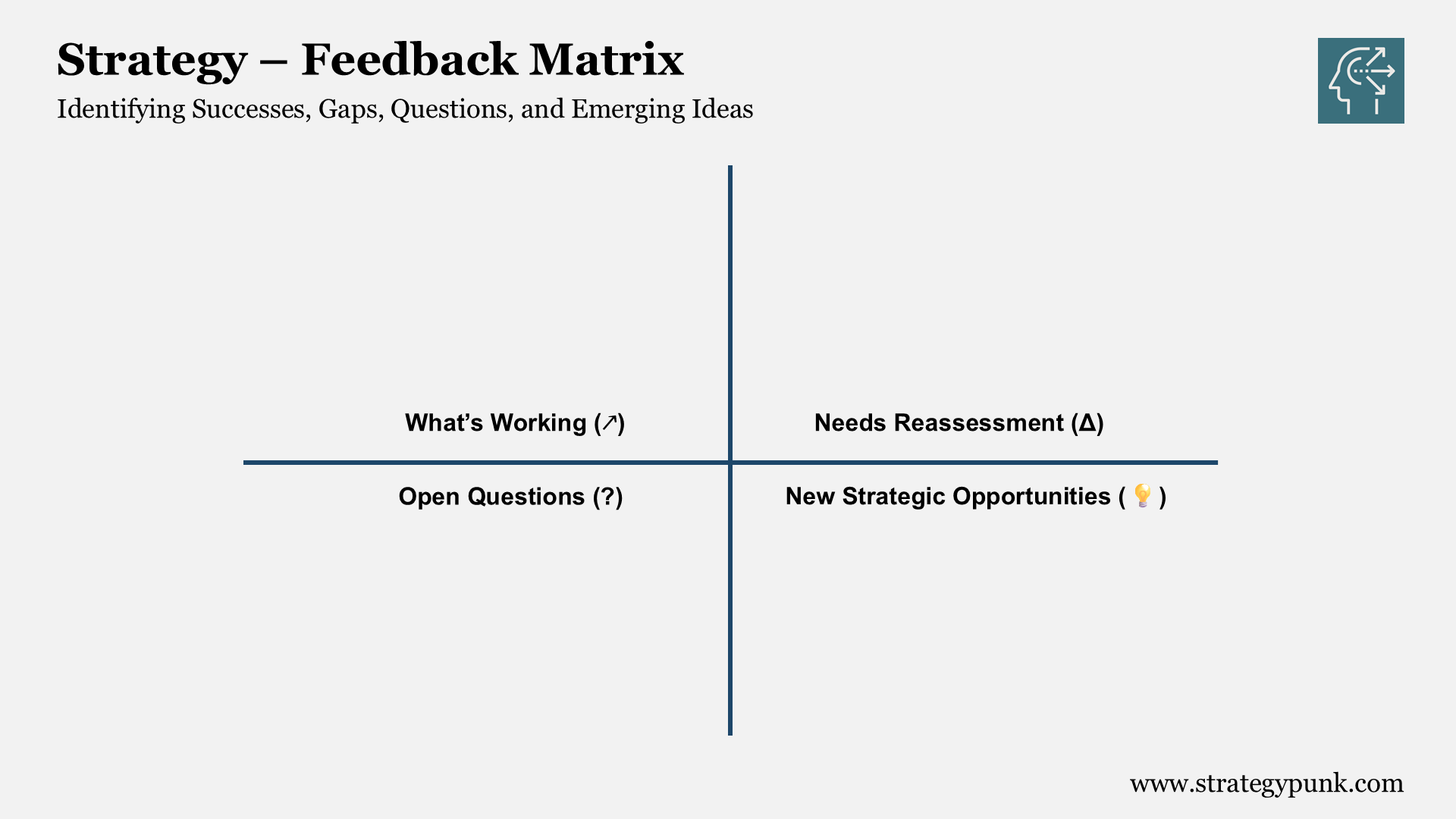The Innovation Playbook: Understanding and Applying the Four Types of Innovation (FREE PPT)
Explore how mastering Product, Process, Business Model, and Management innovations can transform your organization and drive sustainable growth.
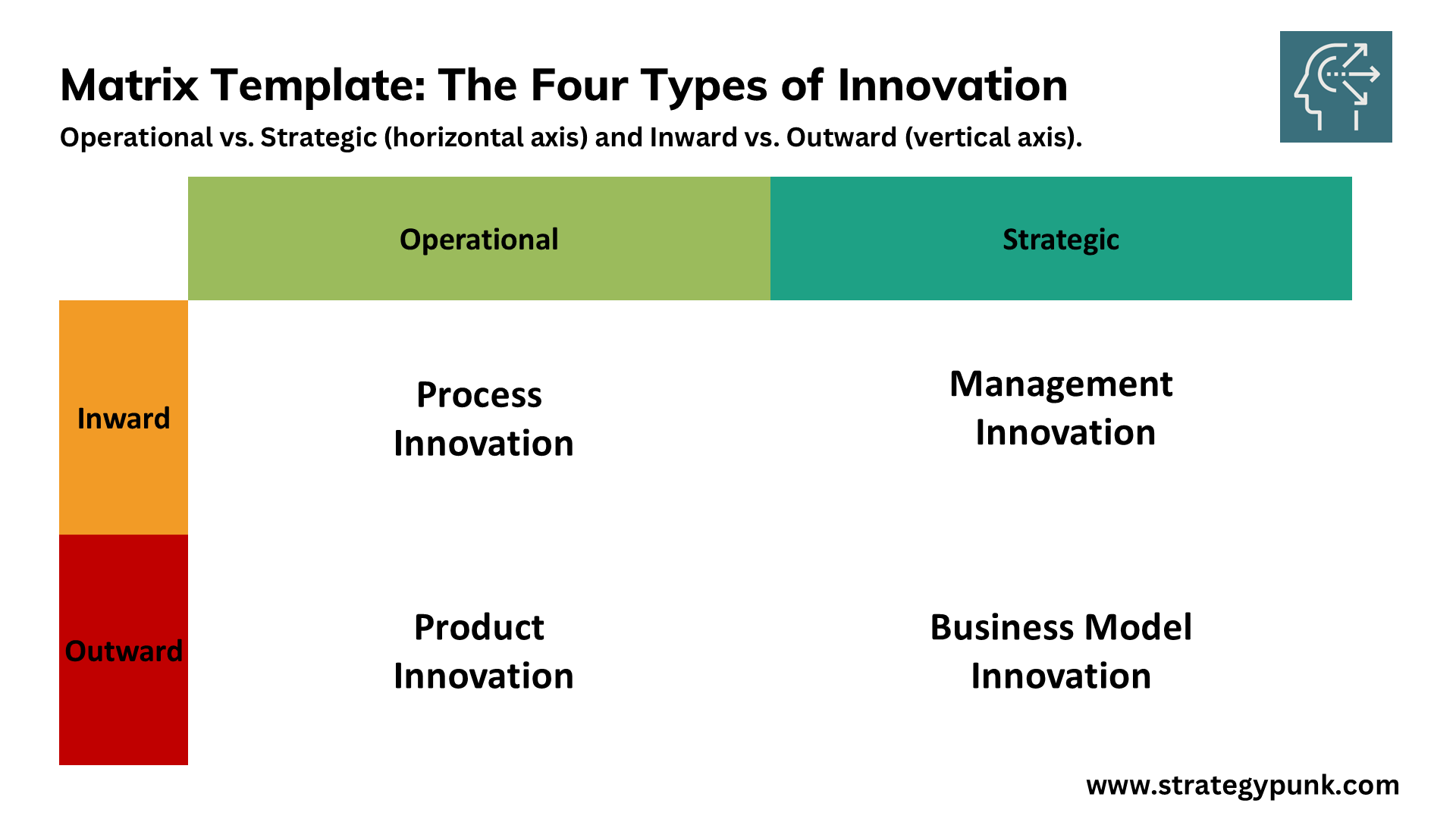
Unlocking Innovation: Understanding the Four Types of Innovation Model
Innovation is the lifeblood of any thriving organization. It drives growth, fuels competitiveness, and fosters adaptability in an ever-changing market landscape. But innovation isn't a one-size-fits-all concept.
Innovation manifests in various forms, each playing a unique role in propelling an organization forward. The 'Four Types of Innovation' model, a comprehensive framework, equips organizations with the knowledge to understand and implement innovation effectively.
This model organizes innovation into four distinct types along two axes: Operational to Strategic and Inward to Outward. Each type represents a specific focus area for driving change within an organization.
Let's examine each type and its contribution to organizational success.
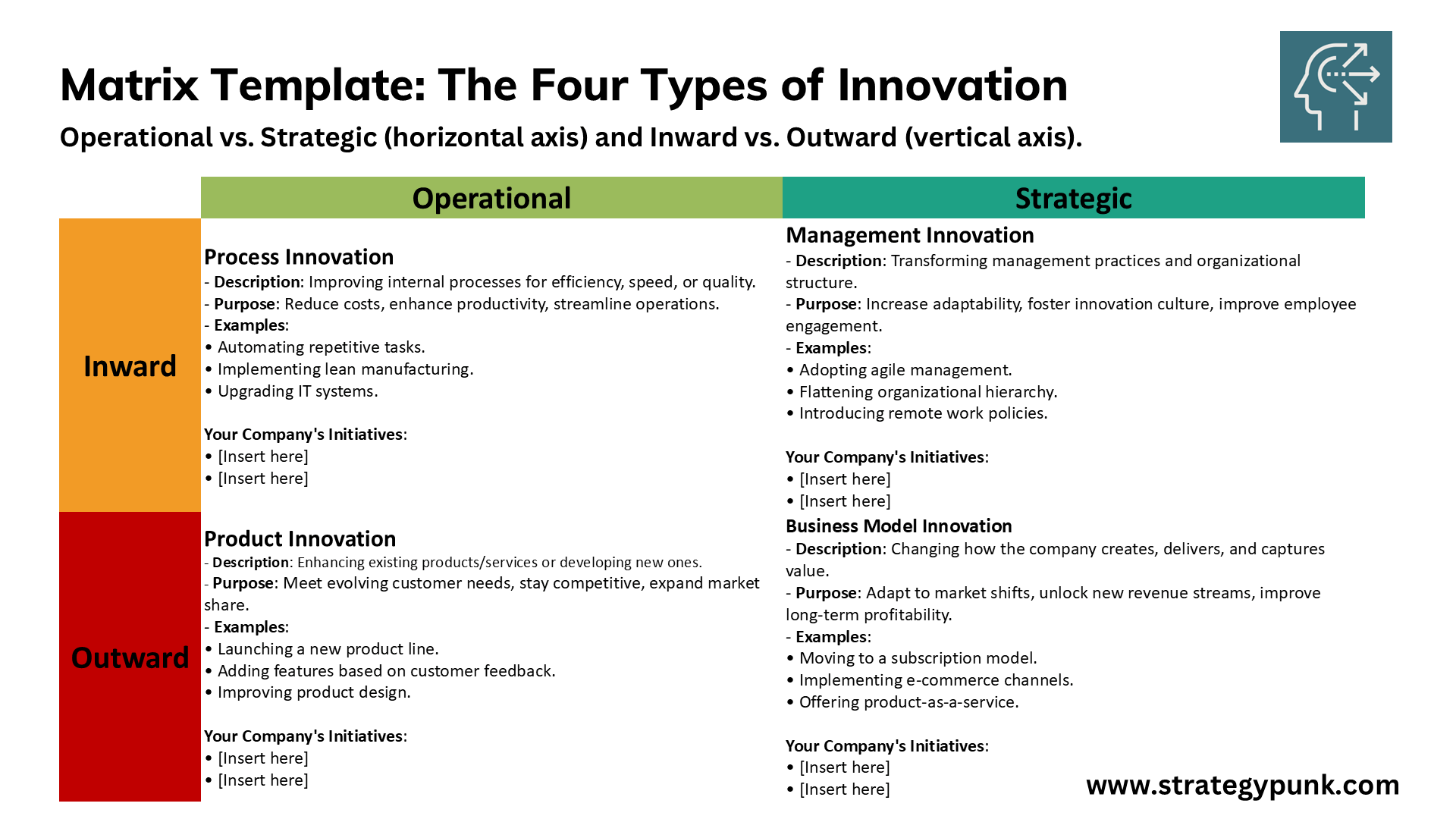
1. Product Innovation (Outward, Operational)
Description: Product innovation is perhaps the most visible and standard form. It revolves around altering, enhancing, or creating new products or services to better meet customer needs.
Purpose: The primary goal is to satisfy customer demands and stay ahead of competitors by continuously improving or diversifying the product offering. This type of innovation keeps the product line fresh and relevant.
Examples:
- Launching a new smartphone model with advanced features.
- Improving the design of a household appliance for a better user experience.
- Adding new functionalities to a software application.
Product innovation is outward-facing and operational because it directly affects the products offered to customers and involves day-to-day operational decisions.
2. Business Model Innovation (Outward, Strategic)
Description: Business model innovation entails changing how an organization creates, delivers, and captures value. It often involves introducing new revenue streams or altering the value proposition to customers.
Purpose: This innovation aims to adapt to or lead market shifts, improving long-term profitability and ensuring the organization's sustainability.
Examples:
- Transitioning from selling products to offering subscription-based services.
- Implementing a sharing economy approach, like ride-sharing platforms.
- Creating new channels for customer engagement, such as e-commerce platforms for traditionally brick-and-mortar businesses.
Business model innovation is outward-facing and strategic, impacting the organization's long-term direction and interaction with the market.
3. Process Innovation (Inward, Operational)
Description: Process innovation focuses on improving the efficiency, speed, or quality of an organization's internal processes. It's about making operations more effective.
Purpose: The goal is to reduce costs, enhance productivity, and streamline daily activities, which will contribute to better overall performance.
Examples:
- Automating manufacturing processes using robotics.
- Adopting lean practices to eliminate waste.
- Utilizing new technology to optimize supply chain logistics.
Process innovation is inward-facing and operational, dealing with internal processes and day-to-day operations.
4. Management Innovation (Inward, Strategic)
Description: Management innovation involves transforming an organization's structure, management, and leadership. This can include adopting new management practices or organizational structures.
Purpose: The aim is to create a more adaptable, resilient, and employee-centered organization that effectively navigates strategic challenges.
Examples:
- Shifting to a flat organizational structure to empower employees.
- Introducing agile management methods for faster decision-making.
- Decentralizing authority to encourage innovation at all levels.
Management innovation is inward-facing and strategic, influencing the organization's culture and long-term strategic capabilities.
Understanding the Axes
The model's two axes help differentiate the innovation types:
- Operational vs. Strategic: This axis distinguishes innovations based on their impact and scope. Operational innovations affect daily activities and processes, while strategic innovations influence the organization's long-term direction and goals.
- Inward vs. Outward: This axis indicates whether the innovation is focused inward or outward. Inward innovations aim to enhance internal processes and structures, thereby improving efficiency and employee satisfaction. Outward innovations focus on creating external value, such as introducing new products or business models that meet market demands.
A Real-Life Case Example: Tesla's Multifaceted Innovation Approach
To illustrate how these four types of innovation work, let's examine Tesla, the electric vehicle and clean energy company known for its innovative prowess.
Product Innovation (Outward, Operational)
Tesla continuously pushes the boundaries of electric vehicle technology. The introduction of the Tesla Model S Plaid, with its unprecedented speed and battery efficiency, exemplifies product innovation. Tesla meets customer desires for cutting-edge technology and sustainability by enhancing performance and introducing new features, such as Autopilot.
Business Model Innovation (Outward, Strategic)
Tesla didn't just innovate cars; it disrupted the automotive industry's business model. By selling directly to consumers rather than through dealerships, Tesla altered the traditional sales model. Additionally, their approach of integrating software updates over the air brings a tech-industry model to automobiles, enhancing customer experience and creating new revenue opportunities through software features.
Process Innovation (Inward, Operational)
Tesla's Gigafactories are a testament to process innovation. By revolutionizing the manufacturing process of batteries and vehicles, Tesla has reduced production costs and increased efficiency. Automation and vertical integration allow for greater control over the supply chain and production quality.
Management Innovation (Inward, Strategic)
Under Elon Musk's leadership, Tesla embraces a culture of innovation and agility. The company's flat organizational structure empowers teams to make swift decisions and fosters a start-up mentality, despite its size. This management style fosters creativity and rapid innovation, which areessential in the fast-evolving tech and automotive sectors.
Balancing Innovation Types for Comprehensive Growth
Tesla's success stems from its ability to leverage all four types of innovation simultaneously. By innovating products, business models, processes, and management practices, Tesla remains ahead of its competitors and continually adapts to market changes.
Organizations can learn from this approach by assessing their innovation strategies across all four types. Focusing solely on product innovation, for example, might lead to missed opportunities in efficiency gains or market expansion through new business models.
Why This Model Matters
The 'Four Types of Innovation' model is a valuable tool for organizations to identify where they invest their innovation efforts and pinpoint potential gaps.
By understanding and applying this model, businesses can ensure a balanced approach to innovation, driving comprehensive growth and adaptation in dynamic markets. This understanding empowers organizations, enabling them to take control of their innovation strategies.
Today, we explore the Four Types of Innovation model, a vital tool for any organization aiming to thrive in a rapidly evolving market.
Innovation isn't just about the following big product; it's about evolving every aspect of an organization to meet future challenges. Whether it's streamlining internal processes, reinventing management structures, introducing groundbreaking products, or redefining business models, innovation must be a holistic endeavor.
Conclusion
In a world where change is the only constant, innovation is not optional—it's essential. The "Four Types of Innovation" model provides a clear framework for organizations to understand and implement innovation in all its forms. By embracing innovation in product, business model, process, and management, businesses can build resilience, drive growth, and maintain a competitive edge.
Organizations should regularly evaluate their innovation strategies against this model and focus on key areas. By doing so, they can create a dynamic and adaptable organization ready to face the future head-on.
Innovation is a journey, not a destination. With a comprehensive approach, organizations can navigate the complexities of the modern market and achieve sustainable success.
Four Types of Innovation PPT & PDF Template
Introducing Your Free Editable Four Types of Innovation Template
To help you seamlessly integrate the Four Types of Innovation model into your organization, we're excited to offer a free, fully editable PowerPoint (PPT) template. This comprehensive resource is designed to make the concepts easy to understand and apply, providing you with a visual and customizable tool to communicate the innovation framework effectively.
Matrix Template: The Four Types of Innovation
Below is a matrix template of the Four Types of Innovation model, organized along two axes: Operational vs. Strategic (horizontal axis) and Inward vs. Outward (vertical axis). This table is designed to be applied to any company and helps you identify and categorize your innovation initiatives.
How to Use This Template
- Identify Current Initiatives: List your company's initiatives or projects that fit the description under each innovation type.
- Brainstorm New Ideas: Use the template to brainstorm potential innovation opportunities in areas that may be underrepresented in your current strategy.
- Customize Examples: To make the matrix more relevant, replace the generic examples with those specific to your industry or company.
- Assess Balance and Gaps: Review the completed matrix to determine if your innovation efforts are balanced across all four types or if there are gaps that require attention.
- Develop Action Plans: For each innovation type, create action plans that outline objectives, timelines, and the responsible teams to drive these initiatives forward.
Additional Tips
- Engage Cross-Functional Teams: When filling out the matrix, include team members from different departments to obtain diverse perspectives.
- Set Metrics and KPIs: Define how you will measure the success of each innovation initiative (e.g., cost savings, revenue growth, customer satisfaction).
- Review Regularly: Make the matrix a living document that you revisit periodically to update and adjust your innovation strategies.
Four Types of Innovation PPT Template
Whether you're planning a strategic meeting, conducting a training session, or developing a presentation for stakeholders, this template offers:
- Clear Visuals: Simplify complex ideas with diagrams and charts illustrating the relationships between Product, Process, Business Model, and Management innovations.
- Customization: Adjust and personalize the content to reflect your organization's specific context, goals, and examples.
- Ease of Use: The material is available in user-friendly formats, including PDF and PPT, allowing you to edit, share, and present it easily.
Download the template to empower your team, spark innovative thinking, and drive transformational growth within your organization.
Start leveraging the Four Types of Innovation to stay ahead in today's dynamic market landscape.
Please consider donating here to support our ongoing efforts if you find this resource helpful.
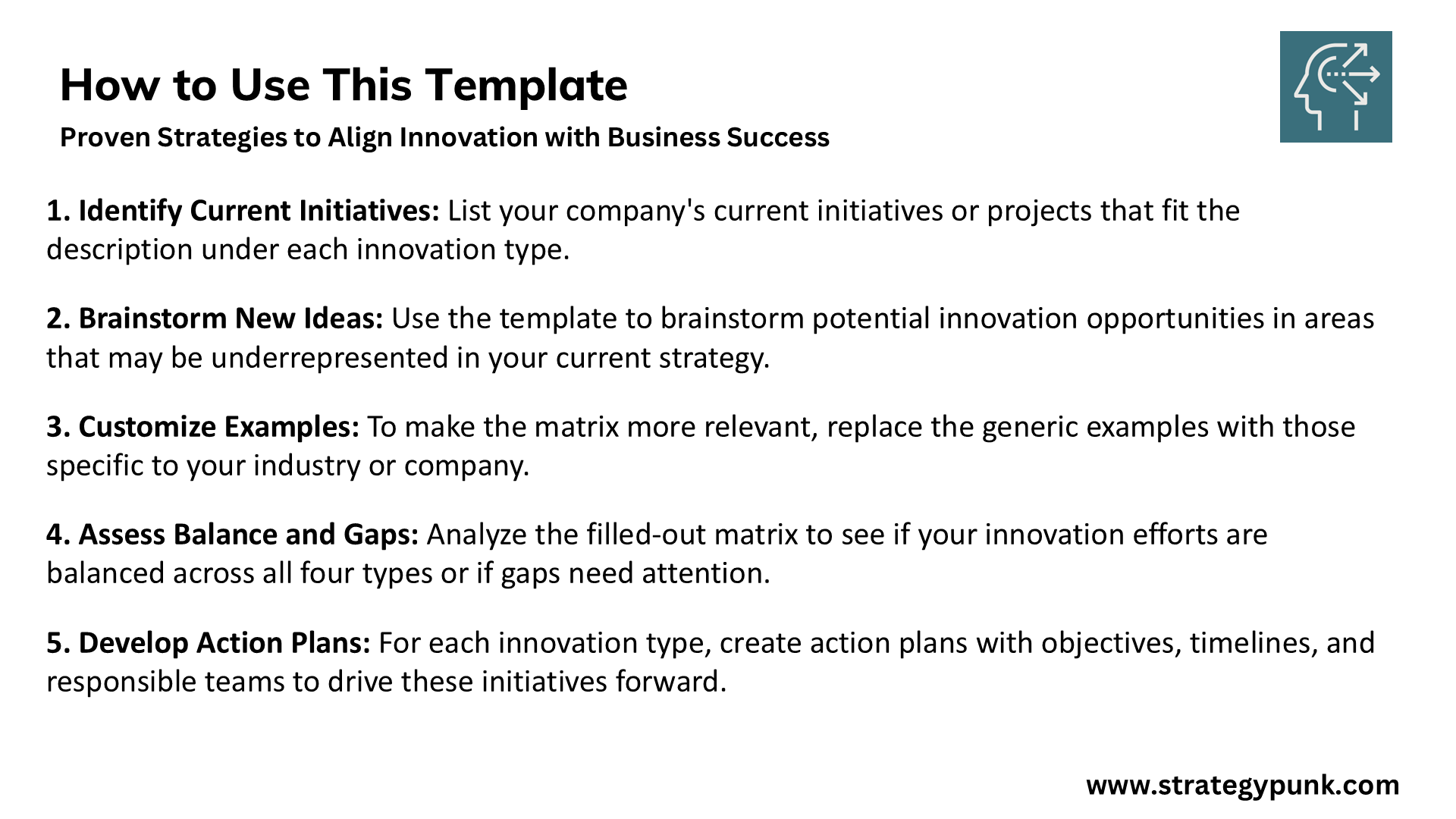
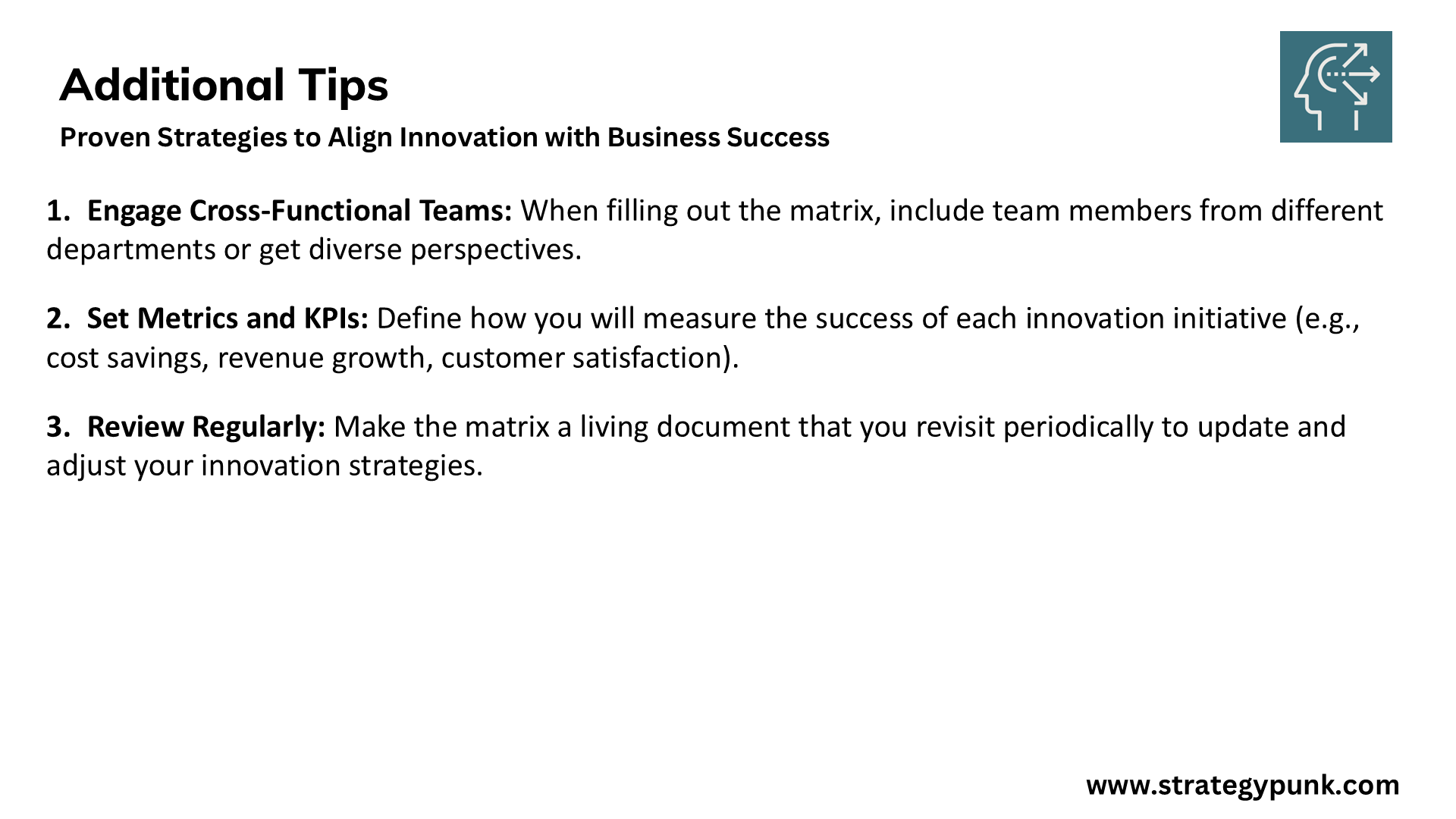
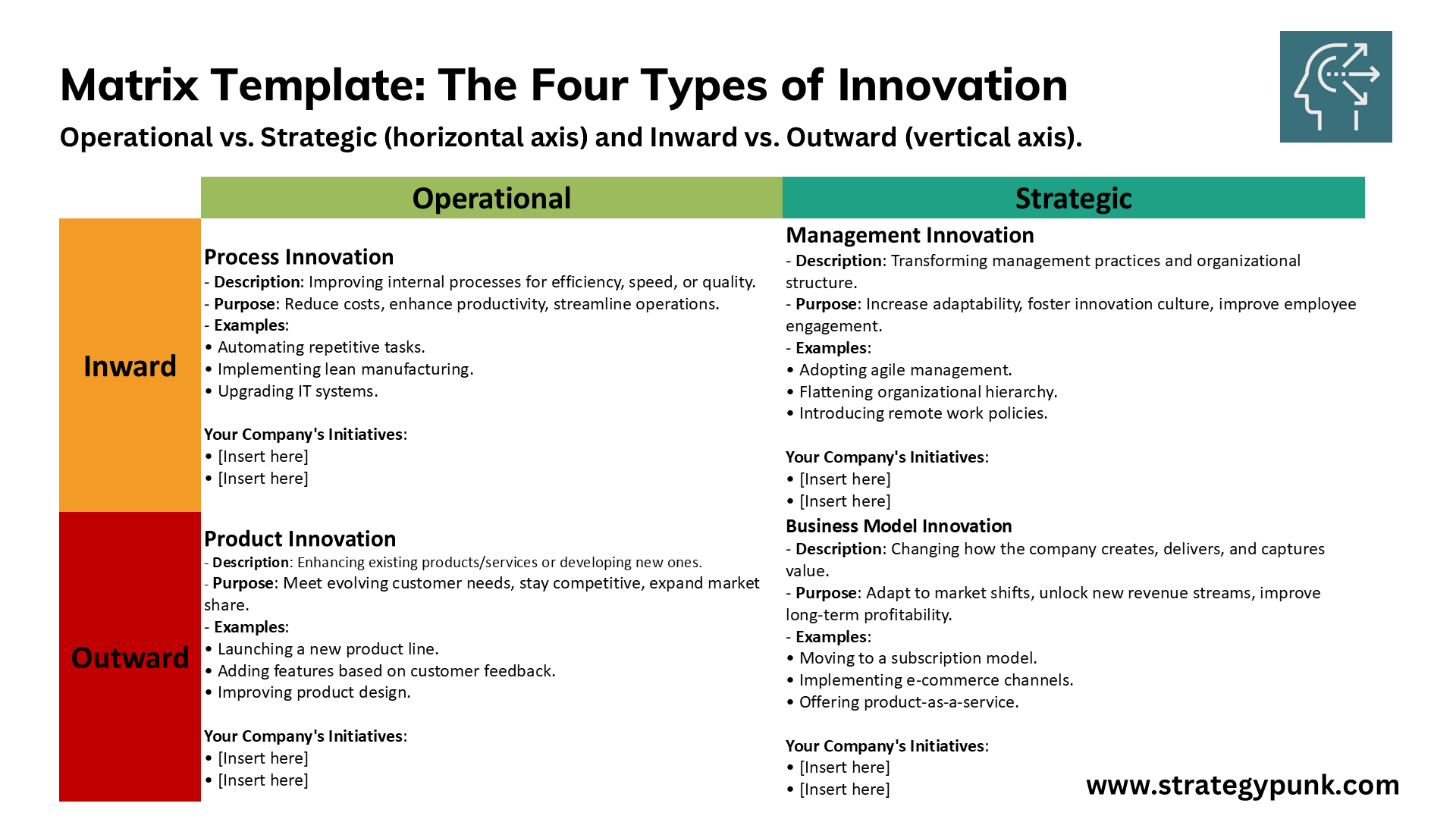
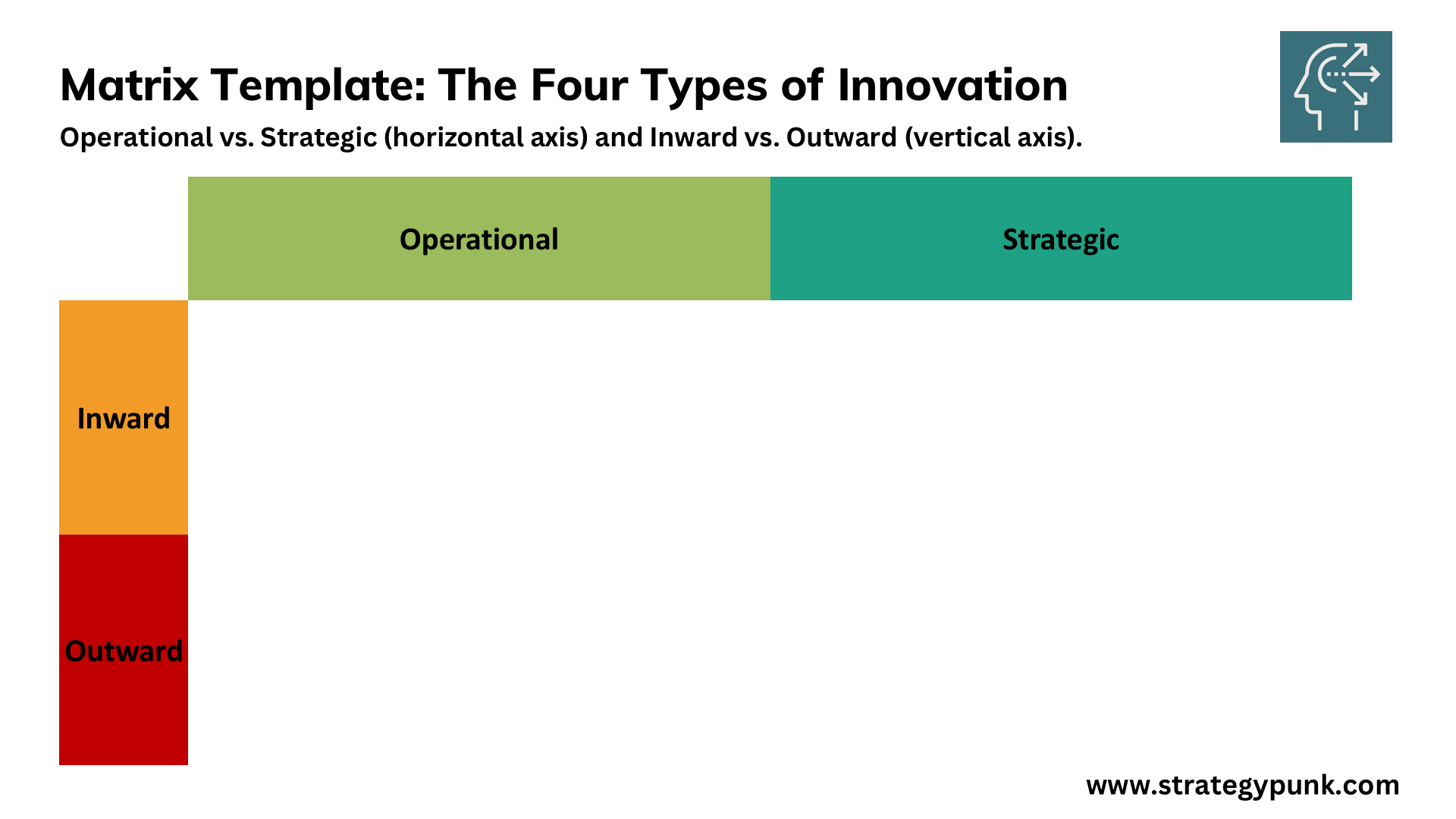
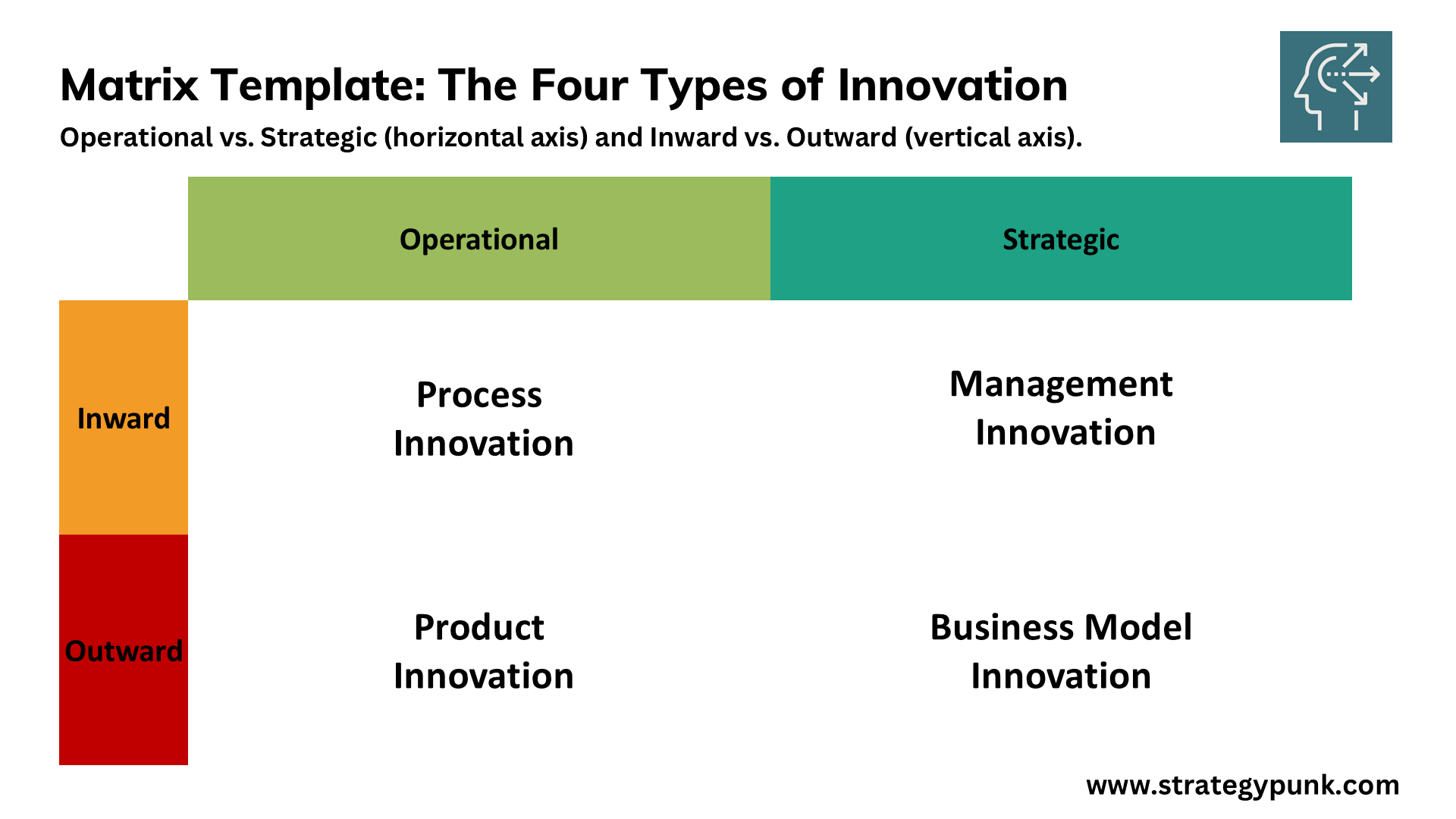
Four Types of Innovation PPT Template




